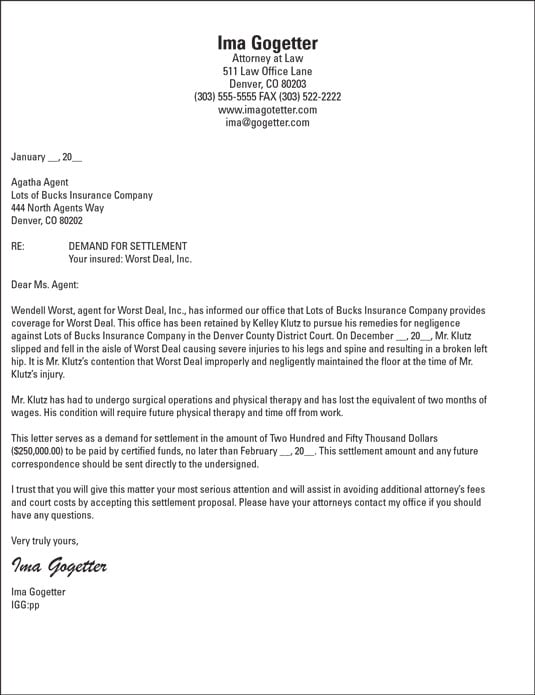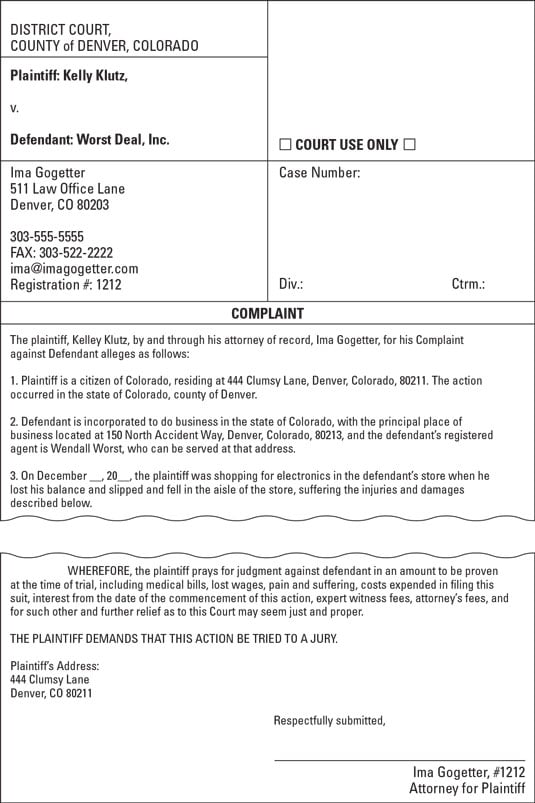After you input a document into your office’s form file database, place a copy of that document into the document files for future reference.
The sample documents here follow Colorado rules, which, like those of most states, are similar to the federal rules. As a paralegal, you should consult your state’s rules to find out the precise formats that your state requires.
Format of a demand letter
You’ll find a wealth of rules, and even whole books, that have been written about proper ways to format a letter. Some paralegals prefer to follow a strict structure to be satisfied that they’re doing the work right, and plenty of material is available in bookstores and libraries to fill this need. For most paralegals, however, following some simple rules, using good judgment, and having pride in appearance will suffice. And spell-check isn’t bad either!A good demand letter should include the following factual information:
- The facts surrounding the incident for which the plaintiff is demanding settlement
- A settlement proposal of either a specific dollar amount or specific action
- The time period in which the defendant must respond
Keep the following appearance guidelines in mind when you put together demand letters:
- Vary the letter’s margin widths depending on its size.
- Short letters: Give very short letters wide left and right margins (usually 1.75″) with a few extra lines placed before and after the date line. Place the body of the letter (address through signature line) at the page’s optical center, which is slightly above the exact center of the page.
- Medium-length letters: Give medium-length, one-page letters margins of 1.25″ to 1.5″ and a little less space before the date line.
- Long letters: Give longer one-page letters 1″ margins left and right. Place the date line two lines below the letterhead, and begin the address line two lines below the date line.
- Avoid making an orphan of the signature block on the second page of a letter. Often, you can fit the body of a letter nicely on one page, but the signature block sometimes spills over onto a second page. To avoid the orphan signature block, you can make the margins wider and force some of the text (preferably a full paragraph) to the second page.
- Always put a colon after the salutation line, even if you use only a first name, like this:
- Dear Ms. Gogetter:
- Dear Ima:
- Don’t number the first page but number the second and succeeding pages of any letter. The style and placement of page numbers doesn’t matter, but your office probably has its own procedure, so be sure to ask how they want it done.
- Begin the complimentary close with a capital letter and end with a comma, like this:
- Very truly yours,
- Yours truly,
- Place about five lines between the complimentary close and the name of the attorney. This gives plenty of room for the signature.
- Reveal the identity of the letter writer by presenting his initials in the block following the signature block. Capitalize the writer’s initials and leave the word processor’s initials in lowercase. For example, if Pat Paralegal were creating a letter for Ima Gogetter, Pat would type “IG:pp” after the signature block.
Follow the initials with a statement of whether there are enclosures and whether copies have been sent to others. Place these revelations underneath the initials and flush with the left margin. Here’s an example of the ending of a letter that contains enclosures with copy information (the cc used to stand for carbon copies back in the olden days before computers and copy machines; now it can stand for courtesy copies):
IGG:ppEnclosure
cc: Rip U. Awff, Esquire
The following figure shows you how all these features come together in a sample demand letter to Worst Deal’s insurance company. (You can find a copy of the demand letter online.)
 A sample demand letter.
A sample demand letter.Make your case: the legal complaint
The format of a complaint (which, in some states and in certain types of lawsuits, is called a petition), varies from state to state, but all complaints should include a caption, text, and a subscription (the attorney’s signature).Because you personally serve a complaint on the defendant, it doesn’t include a certificate of mailing (a statement certifying that you placed the document on a particular date to a specific address). You also file a certificate of personal service with the court.
The caption of a legal complaint
The caption states the court in which the action is filed, the case number, the name of the document, and the names of the parties to the action. A line on the document usually separates the caption from the text of the complaint. Each state has a specific format you should follow for the captions of legal documents.Text of a legal complaint
The text of a complaint must include the following elements in the form of numbered paragraphs in the order that they’re listed here:- An opening paragraph
- A statement of jurisdiction and venue
- A statement of the general allegations against the defendant, which include the specific elements of the offense and the resulting damages
- A prayer for relief
The complaint's opening statement
The opening statement introduces the complaint and explains its purpose. The legal community is slowly changing its format to include clearer, more precise language that omits unnecessary legalese. Old expressions such as whereas and wherefore don’t appear as often as they used to. Even the time honored introductory phrase, “Comes now the Plaintiff, by and through his attorney …” is giving way to more straightforward wording, “The Defendant, by his attorney… .”Establishing parties and jurisdiction
The first numbered paragraph of the text usually identifies the parties with names and addresses and states facts to support the alleged jurisdiction of and venue for the action. For example if the plaintiff brings the lawsuit in a federal district court and relies on diversity of citizenship to give the court jurisdiction, the opening paragraph of the complaint will allege the plaintiff is a citizen of one state, that the defendant is a citizen of another state, and that the amount in controversy exceeds $75,000.Stating the case
The body of the complaint asserts in numbered paragraphs statements that present the case in a logical and sequential order. There’s a difference of opinion on how much detail is needed in alleging the facts on which the plaintiff bases her recovery. The Federal Rules of Civil Procedure (FRCP) and most state rules have come a long way from the old days and require very little factual detail. The discovery process usually fleshes out many of the specific facts in the lawsuit. In a negligence action, alleging that on a certain date, at a described place, the plaintiff slipped and fell on the floor of the defendant’s business, which resulted in crushing the plaintiff’s hip, required him to seek medical help and miss work, and which also resulted in incurred expenses of a specified amount is usually sufficient.Each paragraph in the complaint should state the allegations as succinctly as possible. A good guideline for you to follow is to include only one allegation per paragraph.
Money matters: the prayer for relief
The complaint concludes with a prayer for relief or ad damnum clause, which is a short summary of the plaintiff’s request. This statement may be as simple as, “Wherefore, the plaintiff demands judgment against the defendant in the sum of Two Hundred Fifty Thousand Dollars ($250,000.00) with interest, attorney’s fees, and costs.” Or it may consist of several pages of demands. The prayer for relief may also be more generally worded like this, “The plaintiff demands judgment against the defendant in an amount to be determined at the time of trial, including interest, attorney’s fees, and costs.”The big finish: The subscription
The subscription is the attorney’s signature block. It must contain the attorney’s name, registration number, mailing address, and phone number. Many states also require that the plaintiff’s name and address appear opposite the subscription.In Kelley Klutz’s case, Worst Deal’s insurance company has failed to respond to the demand letter by the designated date, so Ima Gogetter’s paralegal, Pat, drafts a complaint like the one shown in the following figure. (This sample complaint is also included online.)
 A sample complaint with the Colorado caption format. Remember to check the correct caption format in your state.
A sample complaint with the Colorado caption format. Remember to check the correct caption format in your state.See also, "The Paralegal's Role in Creating the Trial Notebook."

